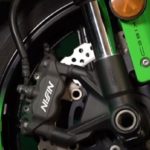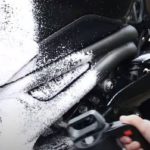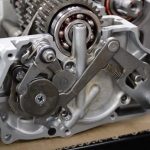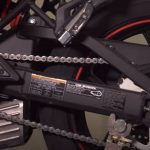Have you ever found yourself in neutral between gears, somewhere other than between first and second? We get loads of questions asking about false neutral, and it seems it’s a problem that plagues many riders.
A false neutral is a neutral that occurs anywhere but between first and second, where true neutral resides. It is most common when you’re upshifting between fourth and fifth or fifth and six, and it can be very distracting and dangerous since you won’t have drive or engine braking as expected.
What Does False Neutral Mean on a Motorcycle?
A false neutral is nothing more than an incomplete shift. Say you’re cruising down the road, and you decide to shift from 5th to 6th gear.
You tow the shifter up, and it disengages the dogs from one set of gears, but because it’s an incomplete shift, it doesn’t fully engage the dogs on the next set of gears.
The drum shift fourth and gears are literally between positions, and that’s possible because there needs to be lateral clearance between gears, so two gears can’t be engaged at once.
The flipside is that no gears can be engaged, but I think we can all agree that that’s a much better option than having your transmission explode.
When you get a false neutral, your best bet is to pull the collection and reship. Unfortunately, when the transmission does go into gear, it might make a nasty noise.
You can help eliminate that or at least reduce it by blipping the throttle to match your engine speed to your ground speed.
How Do You Stop False Neutrals?
The best option, though, is to avoid false neutrals altogether, and the best way to do that is to be deliberate with your footwork and push the shift lever all the way through its travel.

Suppose you’re still having issues with your bike jumping into false neutral or jumping out of the gear you might want to check your shift linkage.
You might also have damaged gear dogs, a bench shift fork, or perhaps the shift star has come loose from the shift drum.
Another question that cropped up a lot in our transmission section had to do with the clunk that you hear and feel when you shift into gear from Neutral at a standstill.
That’s perfectly normal, and it’s just what happens when the dogs on a spinning gear engage with the dogs on a stationary gear or a gear that’s spinning at a drastically different speed.
I know what you’re thinking. If the clutch is pulled in, why is the input shaft rotating?
It wouldn’t be in a perfect friction-free world, but it is spinning because of fluid drag between the clutch plates.
For most people, the motorcycle transmission is one of the most mysterious parts of a bike. How does it work, and why do we shift down into first, but then up for the rest of the gears?
The transmission is one of the most intimidating parts of a motorcycle. There are a lot of sprockets one set of cogs for each ratio in the gearbox. But the transmission operation is pretty straightforward, and so is its purpose.
The whole reason behind the transmission it provides a range of gear ratios to suit different torque needs and engine speeds.
A motorcycle transmission is a constant match sequential gearbox. That means the gears always mesh together, and you shift in order, as opposed to in a car transmission where you can stick it in any gear you want.
Here are all the components laid out. You have your input shaft, which has the clutch mounted to the right end and is turned by the crankshaft, then there’s the output shaft with the sprocket on its left hand that turns the chain and the rear wheel.

Some of the gears are splined to the shaft, but they can move side to side, while others are free to rotate but stay in place.
There are pegs, and they are called dogs, and they nest into corresponding recesses on adjacent sprockets.
When neighboring gears are slid together, their locks and rotate as one, that’s why we call it shifting gears because you are shifting the gears back and forth on the shafts and the way those gears get moved around is by shift forks.
There are three shift forks, and they rest in grooves in the spline gears. At the other end of the forks, there are pins.
They run in dedicated channels in the shift drum, which is this weird-looking thing right here.

When you tow the shifter, it rotates the shift drum, which moves the shift forks and shifts Gears.
But why is first gear down second gear up? Why is neutral between the two of them, and why is the shifter on the bike’s left side anyway?
Let’s start with the political reasons. I think it’s pretty interesting that regulations are stating that the shifter has to be on the left side of the bike and that clicking it up it’s going to move you to a higher gear, and clicking it down is going to move you to a lower gear.
Those regulations were passed in the 70s, and they pretty much served to standardize motorcycle shifting around the world. America was a huge market, and manufacturers everywhere conformed.
As for neutral being where it is, that is primarily a function of safety and convenience.
Neutral could be below first, it could be above 6th, it could even be between third and fourth, but it’s located between first and second because that makes the most sense.
You only shift into neutral when you’re coming to a stop, and you’re only coming to a stop when you’re in the lower gears.
Neutral could be located below first gear, but you might accidentally end up in neutral when you’re trying to shift down into first.
As it stands, you keep mashing down on that lever, and you’ll be in first gear, ready to let the clutch out and pull away from a stop.
There you have it, the basics behind the motorcycle transmission, how it works, and why and if you’ve got sticky shifting on your bike, you might need to change the oil.
As we showed you, there are many rotating interlocking and sliding parts in the transmission, and if your oil is dirty, it’s not going to lubricate that stuff well.
Related Articles
- 4 Things To Wear To Stay Warm On Your Motorcycle In Winter
 Most of us here ride to work every day all year round, and we have lots of personal experience when it comes to taming the elements.
Most of us here ride to work every day all year round, and we have lots of personal experience when it comes to taming the elements. - How To Clean Your Motorcycle In 5 Easy Steps
 We all love a clean and shiny motorcycle but knowing which cleaning products to buy can sometimes be a little daunting, and so too can be the method to clean your motorcycle.
We all love a clean and shiny motorcycle but knowing which cleaning products to buy can sometimes be a little daunting, and so too can be the method to clean your motorcycle. - How Does A Manual Transmission Work On A Motorcycle
 For most people, their motorcycle transmission is one of the most mysterious parts of their bike. How does it work, and why do we shift down into first, but then
For most people, their motorcycle transmission is one of the most mysterious parts of their bike. How does it work, and why do we shift down into first, but then - How Sprockets Affect Speed on Motorcycles And Why
 It doesn’t matter if you’re a racer; if you’re just into trails riding your dual-sport, your bike can be geared differently to your performance needs. Not only on a dirt
It doesn’t matter if you’re a racer; if you’re just into trails riding your dual-sport, your bike can be geared differently to your performance needs. Not only on a dirt - 3 Reasons Why Wheelies Are Bad For Your Motorcycle
 Wheelies are super fun, and we all know that wheelies are one of the purest forms of joy known to humanity, but they can be dangerous. Wheelies are bad for
Wheelies are super fun, and we all know that wheelies are one of the purest forms of joy known to humanity, but they can be dangerous. Wheelies are bad for


